
鮨 田中
Sushi Tanaka ◆ 鮨田中
3.35
Shirogane
「Sushi」
20,000-29,999円
--
Opening hours: Monday, Tuesday, Wednesday, Thursday, Friday, Saturday
18:00 - 23:00
Sun.
Closed
Rest time: Business hours are in two parts. [Part 1] 18:00~20:30 [Part 2] 20:30~23:00 ■ Closed Sundays and irregular holidays.
東京都港区南麻布2-7-23 マーキュリー南麻布 1F
Photos
(20)
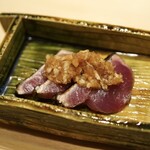


















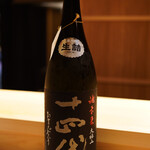
Details
Reservation Info
Reservations are accepted, but not if you are wearing perfume or other strong scents.
Payment Method
Credit cards accepted
(VISA, Master, JCB, AMEX, Diners)
Electronic money is not accepted
QR code payment is not accepted.
Number of Seats
8 seats
Private Dining Rooms
None
Smoking and Non-Smoking
No smoking at the table
Parking
None
Coin-operated parking available nearby
Facilities
Stylish space, calm space, counter seating available.
Drink
Sake available, shochu available, wine available, stick to sake, stick to shochu, stick to wine
Dishes
Focus on fish dishes
Comments
(21)
ゼンジン30131
4.50
This is my second visit to a restaurant close to home with some friends. It's so close that we rarely come, but it was great to go together. The food is delicious. The quality of the fish is excellent, and I really like the tanginess and cooking of the rice as well. And above all, it's a great value for the price. This is definitely a place I can visit regularly, which I'm really grateful for. This time, I particularly enjoyed the blue fish and the new squid! I will definitely come again!



k.ooo
5.00
This is a wonderful restaurant! I have been a fan since the time of Mr. Risaki, and I visited after hearing that he has become independent. The chef has a great personality, the atmosphere is calm, and all the dishes are delicious. It's truly an exceptional sushi restaurant!




chocosara
4.20
Located just a 10-minute walk from Platinum Showa Station, this hidden sushi restaurant, which opened in February 2024, quietly stands in a spot that can easily be missed. Upon entering, the pleasant scent of incense wafts through the air, and I'm captivated by the beautiful wooden counter and the calming interior decor.
▪️Omakase Course: The course starts with a variety of small dishes before transitioning to sushi.
◻︎ Ginkgo nuts seasoned just right with salt, delicious.
◻︎ Returning bonito, smoked with straw, offering a rich aroma. The bonito itself is fatty and packed with flavor.
◻︎ Sardine wrapped with seaweed, incorporating sardines, myoga, and cucumber. The sardine’s rich fat melts in your mouth, perfectly complementing the refreshing crunch of cucumber and the spiciness from myoga.
◻︎ Octopus foot braised for 7 hours in roasted tea, while the head is steamed for 30 minutes. The octopus has a pleasantly chewy and tender texture, paired with a refreshing aroma.
◻︎ Hairy crab, served with a slightly tangy sauce, allowing the natural flavors of the crab to shine through.
◻︎ Mejikara, grilled to perfection with crispy skin and a rich, decadent taste.
◻︎ Abalone, with a plump and supple texture. The deep green liver sauce is rich, and when combined with the rice, it pairs beautifully and encourages more drinking.
◻︎ Sanma, thick and fatty with a generous flavor, truly luxurious.
◻︎ White squid, maintaining a nice texture, seasoned perfectly.
◻︎ Aomori’s Ryūhi red meat, from about a 230 kg tuna. It has a delicate and moist texture with concentrated umami flavor.
◻︎ Chūtoro, abundant with quality fat that melts in your mouth. It pairs excellently with the red vinegar rice.
◻︎ Seabream cured with kelp, enhancing its subtle taste with the umami from the kelp, creating a rich flavor.
◻︎ Marinated mackerel, refreshing with a tangy taste while strongly savoring the mackerel’s flavor.
◻︎ Shrimp, with a chewy texture, releasing its flavor with every bite.
◻︎ Mini bowl of fresh salmon roe, rice cooked with stock and salt, combined with uni. The cooked roe is white with a creamy taste, offering a novel experience. All ingredients are of high quality, and the pairing with sushi rice is superb.
◻︎ Anago, served hot. The surface is crisp and fragrant, while the flesh is fluffy and deliciously complemented by a sweet sauce.
◻︎ Egg, fluffy omelet made from yam.
◻︎ Red miso soup, with a hint of sweetness from shellfish, a favorite of mine.
▪️ Extras:
◻︎ Toro-taku, delicious fatty tuna paired with crunchy takuan. It’s impossible not to love!
▪️ Sake: Ubushina, Juyondai, Ura Kiyama, Juyondai 30 years.
The young head chef is friendly yet calm and composed, pursuing the artistry of sushi with remarkable dedication. You can sense a sharp, unique talent. I’m eager to return and have already made a reservation for three months later. Thank you for the wonderful meal.
Visit rating on Tabelog: ⭐︎3.35



お鮨TARO
4.00
This is my third or fourth visit, and once again it was consistently delicious. It's amazing that they can offer such high-quality ingredients at this price; I don't think many places could do it like Matsuo. The chef, who is a sushi lover, does an incredible job of exploring and perfecting the ingredients. The selection of sake is also fantastic, and I was able to enjoy a tasting of different varieties of Juyondai.

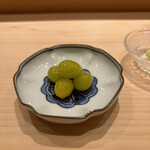

seiji5525
5.00
This restaurant has a serene atmosphere and a relatively new hinoki wood counter, making it a comfortable place to enjoy a leisurely meal. The young chef, Tanaka, provides a warm and attentive service that reflects his Kyushu roots, adding to the enjoyable dining experience. Every dish is spot on, leaving both my stomach and heart satisfied. I will definitely visit again!



maru2751
5.00
It was very delicious! The structure of the meal had no weak points from the beginning to the end, making for a very enjoyable two hours. Since it’s just after opening, it’s easy to make reservations now, but I think it won’t be long before it becomes a difficult-to-book restaurant. They also have a selection of several types of sake, including Junmai Daiginjo and Aramasa, all at very reasonable prices. I’ll definitely be coming back!

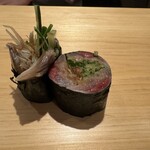

イラマチ男タコ蔵
4.50
I hope this message finds you well. It’s been a while since I last wrote, and I’m Iramachi Otoko Takokura. I still visit sushi restaurants at least three times a week, but without any new places piquing my interest, my posts on Tabelog have been stagnant. However, I’ve recently encountered a fantastic new restaurant that compelled me to pick up the pen again. Today, I’m reviewing "Sushi Tanaka," located in the Azabu-Juban and Shirokane area.
The chef, Ryuu Tanaka, is only 30 years old and exudes the aura and customer service of a seasoned veteran. You can feel his quiet determination towards sushi. Whether you're a first-time visitor or a regular, you can expect a warm, welcoming atmosphere. Even someone like me, known as the "Sushi World’s Motherf*cking Waste," is treated kindly, which truly speaks to his character.
Chef Tanaka hails from Amakusa, where his family runs a well-known yakiniku restaurant and livestock business. He moved to Tokyo to pursue a career in dining, working under Shin Suetomi, the owner of Suetomi-style and Maki Bird Shin Kobe, and later trained in sushi under Chef Mouri at Shibuya Sushi Risaki.
Now, let me share my second visit and the dishes I enjoyed. (Please note that due to a typhoon hitting Kyushu during my visit, many of the dishes came from different sources than usual.) Unlike the traditional sushi chef styles that alternate between small plates and sushi, here you’re served all the small plates before moving on to the sushi, which I personally prefer.
**Small Plates:**
- Mozuku: Seaweed from Iwate with ginger. Perfect for summer, it whets the appetite with its acidity.
- Marinated Bonito: From Kesennuma, it’s juicy with a pleasant acidity. A novice would assume heavily fatty bonito is the standard.
- Sardine Roll: A light sardine roll with vegetables. The rolling technique is beautiful and fast, probably neater than a joint rolled by Snoop Dogg.
- Soft-boiled Octopus: Extremely tender, though I personally prefer a bit more texture for added bite.
- Hairy Crab: Its warm, slightly firm texture and the taste of crab vinegar were wonderful. Truly delicious.
- Sawara (Spanish Mackerel): Served hot with radish. Very tasty.
- Black Abalone: It's incredible to get such high-quality abalone in a course priced in the tens of thousands of yen. The cost could very well be at a restaurant charging 35,000 yen per person. The liver sauce with finely chopped pickled onions provided the perfect texture and flavor. This was outstanding—better than the original.
**Sushi:**
The sushi rice is a mix of rice vinegar and red vinegar, cooked to a consistency that evokes a slight texture, partly reminiscent of brown rice. The rice is cooked in two different ways to adjust firmness, intended to increase chewing. I really liked this. While the flavors aren't overwhelmingly sour or salty, Chef Tanaka’s effort and experimentation represent true sushi craftsmanship.
- Kinmedai (Golden Eye Snapper): Wrapped skin inside. Seasoned with kombu, the moist texture and just-right fat content cater to my taste.
- Sanma (Pacific Saury): A 13-tail size, this is a seasonal delight. The bitter liver adds a great balance—truly a sophisticated sushi.
- Horse Mackerel: From Amakusa, sourced directly from local fish markets. The treatment is excellent with days of aging that enhance the flavors.
- Kohada (Gizzard Shad): Lightly marinated, this one from Osaka Bay perfectly complemented the sushi rice.
- Botan Ebi (Sweet Shrimp): This was delicious. The large botan shrimp marinated in shrimp miso, soy sauce, and Shaoxing wine paired perfectly with the sushi rice. The seasoning was exceptional.
- Tuna: From the belly of Canadian tuna, sourced from the trusted dealer Hina. After trying many Canadian tunas recently, I found this one delicious. It's nonsensical to dismiss it just because it’s not local. The red and medium-fat tuna were both marinated, with the red being marinated longer.
- Sea Urchin: High-quality, definitely on the pricier side, which made me chuckle. With two young apprentices and a prime location, I worry about their profit margins, especially given the taste and size of the leaves.
- Anago (Conger Eel): Grilled hot after being braised, this comes from Miyagi. I love eel when it's hot.
- Soup: Using Amakusa’s barley miso, it’s enriched with fish, shrimp, and crab dashi. This was incredibly delicious—if the woman I briefly met the night before made this for breakfast, I’d undoubtedly want to spend the night with her again.
- Soup: Using sweet shrimp, this was a fluffy egg creation.
With this number of dishes and their quality, all under challenging conditions due to the weather, the price for one person was 19,000 yen (including tax). Having visited Toyosu Market and established connections with various dealers, I’m quite aware of most seafood and sea urchin costs. Honestly, if one were to calculate properly, I’d guess the running costs would be between 28,000 to 35,000 yen in order to remain viable.
I'm truly excited for Chef Tanaka’s future success as a craftsman. His unwavering effort and dedication deserve maximum respect.



お鮨TARO
4.00
This is a new restaurant opened by Mr. Tanaka, who graduated from Sushi Risaki. They are currently offering dishes at nearly zero profit as a special opening promotion! The quality of the food justifies this pricing, as they insist on sourcing high-quality ingredients, such as black abalone from Chiba, without compromise. Additionally, for those who love sake, they boast an incredible selection of rare Junmai Daiginjo, including many types of Jouzan that you won’t find elsewhere. The price range and atmosphere make it very approachable, even for sushi beginners. I definitely think you can go alone without any issues.



メガネ君.
3.70
Just a little under a 10-minute walk from Shirokane-Takanawa Station, the distance to the restaurant is just right to build excitement and imagination.
- Mozuku vinegar
- Sashimi: white amadai, kanpachi
- Iwashi (sardine) wrapped in nori
- Simmered octopus
- Hairy crab with seasoned sake? MVP!
- Salt-grilled swordfish with grated daikon
- Abalone with liver sauce and rice
◎ Salmon roe
◎ Baby sea bream
◎ Pencil squid
◎ Horse mackerel
◎ Tuna
◎ Chutoro (medium fatty tuna)
◎ Gunkan with layered skin
◎ Botan shrimp
◎ Surf clam
◎ Sea urchin gunkan
Started with some small dishes and then moved to a series of nigiri, having already enjoyed some drinks in the first half. The chef’s love for sushi clearly shone through in the course.



be_0ka
5.00
I heard that the person who served as the head chef at Risaki in Aoyama went independent in February this year, so I decided to visit. Every small dish paired perfectly with the drinks, making me feel like I got my money's worth just from those alone. And of course, the abalone was outstanding. The slowly simmered boiled octopus was tender, and the nori rolls had a delightful aroma from the condiments and seaweed, giving a luxurious salad-like experience. The nigiri had a firm rice that I really liked, especially the tuna, which had a perfect balance of the deep flavor from the lean part and the melt-in-your-mouth fat from the medium fatty part; it was truly impressive. The eel was wonderfully soft and fragrant, making it an ideal final piece of nigiri. I was amazed that such a high level of quality and satisfaction could be found at this price. I struggle with the desire to spread the word about this hidden gem while also wanting to keep it to myself.



くまトンキチ
4.10
There is a restaurant within a 10-minute walk from Shirokanetakanawa Station in Minami Azabu, Tokyo. It opened this February, and since it’s close to the hotel I was staying at and has great reviews on Tabelog, I decided to visit. The owner is from Amakusa in Kumamoto Prefecture, and many of the ingredients are sourced from his hometown. Additionally, the restaurant’s sign was written by Mori Seihan, the chief priest of Kiyomizu Temple, who writes the "Kanji of the Year."
The restaurant offers a variety of creative dishes, from appetizers to sushi, all at an incredible price-to-quality ratio, which was a pleasant surprise! I believe it will soon be difficult to make a reservation, so I recommend visiting early. Everything was truly delicious, and I've added another restaurant to my must-visit list!
- The appetizer of mozuku (seaweed) and suzuki (water plant) with vinegar was refreshing, with a great texture from the large suzuki.
- The Ishigakigai (a type of clam) was in season only at this time, boasting a wonderful sweetness and texture reminiscent of torigai (another type of clam).
- The sushi roll with sardines, cucumber, and myoga was a favorite of the owner and has become a signature dish—an exceptional appetizer.
- The freshly boiled baby octopus was well-cooked with a fantastic texture.
- The steamed rock oyster from Mie Prefecture concentrated the flavor of the oyster, enhancing its umami.
- The seared ribbonfish was delightful.
- The fried grouper from Amakusa was exquisite, with a refined taste that could easily become addictive.
- The dish featuring black abalone with liver sauce and vinegared rice was outstanding, showcasing a high level of culinary skill.
- The gari (pickled ginger) served as a palate cleanser was thinly sliced.
Now, on to the sushi. The rice was slightly softer than usual.
- The konbu-dried snapper was incredibly delicious, and I’d love to try it as sashimi.
- The white squid is known as swordtip squid.
- The aji (horse mackerel) was fresh.
- The "Toki Shirazu" (summer salmon) was delightful.
- The red lean tuna from Boston was noted to be best during summer.
- The medium fatty tuna from Boston was a real treat.
- The surplus piled high in the Toro-taku (tuna and diced vegetables) made it feel like a great deal.
- The kohada (gizzard shad) on konbu was already delicious enough on its own, even without the seaweed.
- The botan shrimp was excellent.
- The bafun uni (sea urchin) was sublime!
The miso soup made with barley miso from Amakusa paired beautifully with various seafood, providing deep, rich flavors.
- The grilled boiled eel was fragrant with just the right amount of sweetness.
- The tamagoyaki (Japanese omelet) was warm and quite tasty.
Lastly, I tried the recommended sake: Yamadanishiki from Umato and summer junmai.



aco1102
5.00
I visited Sushi Tanaka in Azabu after quite a while! The photos only show the nigiri, but the appetizers were delicious too, especially the black abalone with liver sauce, which was simply outstanding! I've had similar dishes at other places, but I find it truly mysterious how they manage to make the liver sauce so rich and flavorful. I will definitely visit again.



nao316885
4.50
I visited Sushi Tanaka in Azabu, and it was truly a wonderful restaurant. It's a bit of a distance from Shirokanekawara, but they have only counter seating, accommodating just three groups a day. Each dish was carefully prepared and incredibly delicious. The way they boiled the scallops was excellent, and the seasonal fish had a great layer of fat, making it very tasty. The raw shrimp was delicious, but I heard that the boiled shrimp is exceptionally good. Unfortunately, it’s not in season right now, so I plan to come back in three months. It was an absolutely amazing restaurant.
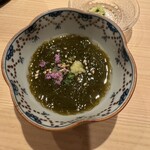


ダイエット欲より食べたい欲が勝ってる
4.00
Everything was incredibly delicious! You could really feel the chef's commitment to quality. The standout dishes for me were the bonito rolls, abalone, otoro (fatty tuna), and sea urchin! But honestly, everything was delicious. The atmosphere was lovely, and the head chef was friendly, creating a delightful experience overall.



buska
3.70
The location sounds elegant, but it's quite far from any station and inconvenient. However, the distance is just right for a walk, which is good for your health. I wonder how a walk in mid-summer would feel. The interior is pristine, with a spacious and relaxing atmosphere that feels surprisingly calming for a first visit. There is a wide variety of snacks available, and all the classic dishes are well-prepared and satisfying. The sushi, while lacking in standout features, was delicious. The rice had a slight sourness that I enjoyed, and I think it would appeal to many people. Overall, the level of service was very meticulous, leaving a great impression. I would love to visit again if I get the chance.
Sushi Menu:
- Iwashi with irizake
- Refreshing myoga and shiso
- Tsubu (periwinkle)
- Octopus
- Fugu (pufferfish) milt
- Hairy crab
- Swordfish
- Abalone
- Abalone liver rice bowl
- Sand dab
- Squid
- Horse mackerel
- Tsubu
- Black rockfish (grilled directly with ink)
- Lean tuna
- Medium fatty tuna
- Kohada (shad)
- Sweet shrimp (boiled to perfection)
- Sea urchin
- Eel
- Added omelet
- Kanpyo roll



k.tokky
4.10
I visited Mr. Tanaka for the first time. Both the sushi and the appetizers were delicious. They even served me seafood from the liver, which made me very satisfied. Although I didn’t get a picture of the sushi, everything was tasty. Given that high-end sushi places in this area have become quite expensive, I felt that paying around 22,000 yen per person, especially with some light drinking, was a great value for the quality offered. The chef also had a wonderful atmosphere, and I would definitely like to visit again.



きたくぶ
4.20
This is definitely a place you should visit early! I honestly think it's impossible to offer such quality at this price, in a good way, of course. The black abalone and the prime cuts of tuna from Higan are just amazing, reflecting the chef's strong reputation. Both the appetizers and the sushi are flawless—absolutely outstanding!



ひーちゃん1285
4.50
The omakase is 19,000 yen, and the sake ranges from 1,000 to 1,500 yen. It focuses on fresh fish from Amakusa, and it's delicious and offers incredible value. The menu includes unique items like new shoots of mozuku seaweed and jun-chan sea bream from Akita, with a hint of plum flavor, simmered sardines wrapped in seaweed, sake-steamed knife fish, and hokkigai (surf clam) with its siphon. There's also grilled black mullet, natural abalone with liver sauce, which can be turned into a risotto by mixing the leftover sauce with sushi rice. The dish features seasonal ingredients like flounder, watermelon, hokkigai, medium fatty tuna, red tuna, horse mackerel, and fatty tuna wrapped in seaweed. Additionally, there are kohada (gizzard shad), sweet shrimp, sea urchin, eel, and a tamago (Japanese omelette) soup.



ザキone➕
4.50
It was my first time visiting. I was taken there as a birthday celebration. The manager, who trained at another restaurant, opened this place in February. First of all, the interior is beautifully done and very compact, which is wonderful! We started with some appetizers, and everything was meticulously prepared, showcasing incredible flavors. As we moved on to the main dishes, we were served sushi that was just the right amount... The drinks were delicious too, and I’m definitely coming back for more!



あすぽん0513
4.80
I couldn't forget the amazing experience I had in March, so I visited again. Everything I ate this time was exquisite, but the standout dishes were the smoked katsuo (bonito) with straw, and the sushi featuring ishirako (stone flounder) and sakuramasu (cherry salmon). Since it was also a celebration for my friend's birthday, we enjoyed champagne by the glass. This time, I focused on sake, but I’d love to pair it with wine next time. I plan to come again next month.



NoName44
4.00
I had a sudden craving for sushi and decided to call "Sushi Tanaka" in Platinum Tower, thinking I might not get a reservation. Fortunately, I managed to get a spot! Lucky me! Chef Tanaka used to head the Ritsuki Aoyama restaurant and opened this place independently in February this year. I opted for the omakase menu for 19,000 yen and added four cups of sake, bringing the total to 23,000 yen! I was extremely satisfied! Here’s what I had:
- Steamed Hairy Crab Chawanmushi
- Meji Maguro (medium-fatty tuna) from Himi, grilled over binchotan charcoal
- Sardine Sushi wrapped in seaweed
- Sliced Turban Shell
- Boiled Octopus from Amakusa
- Firefly Squid from Toyama, grilled over binchotan charcoal
- Wild Black Abalone with liver sauce
- Stone Sea Bream, aged with kelp
- Cuttlefish
- Horse Mackerel
- Cherry Salmon (the back part)
- Medium Fatty Tuna from Wakayama Nachikatsuura
- Marinated Red Tuna
- Young Gizzard Shad
- Sweet Shrimp
- Low-temperature cooked Boiled Clam
- Bafun Sea Urchin from Nemuro, Hokkaido
- Purple Sea Urchin from Amakusa
- Miso Soup
- Grilled Eel
- Tamago (Japanese omelette)
Sake:
- Aramasa, Cosmos of Autumn
- Kamo Kunshu, Lightly Cloudy Sake, Namazake
- Tedori River, Junmai Daiginjo
- Nabeshima, Junmai Daiginjo
Chef Tanaka is from Amakusa, and it's evident that many ingredients and tableware from that region are used here. Overall, the omakase offered a delightful experience with fragrant dishes. The Cherry Salmon was particularly impressive; though it was the back piece, its aging gave it a melting texture and wonderful aroma! The specialty dish of abalone with liver sauce was top-notch, perfectly paired with the rice!
You can sense the energy of ambition and drive from Chef Tanaka, who is in his twenties. It was inspiring for me too. Since the restaurant just opened, it's relatively easy to get a reservation, so I highly recommend it!
---
On Instagram, I share more detailed recommendations for places to eat, so if you're interested, feel free to search! I cover hard-to-book places, top 100 listings, B-grade gourmet, delivery options, and more, regardless of category!
======
Check out my Instagram: @kozaru.gohan. I'm looking forward to your follows, likes, and saves!



Email Login